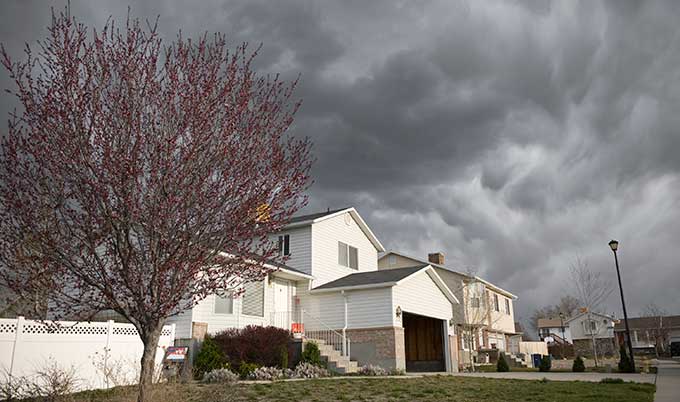The weather is the enemy of the home, and the chimney is no exception. There are many ways natural disasters can end, and they tend to live up to their name; in other words, if you aren’t prepared, things will be disastrous. So, no matter the weather, here’s a helpful guide on keeping your chimney standing and well.
Hurricanes, Rainstorms, & Tropical Storms
Hurricanes, be they called Tropical cyclones or Typhoons, are not too demanding on you for set up. Any advice will also apply to Tropical Storms or Rainstorms so if you are in a rainy region, listen up.
First, the fireplace, search the firebox for any cracks, gaps, or other signs of wear. Water is the villain for both architecture and engineering, and if there is one thing, these storms will be throwing its water. Mend any issues you find before the storm arrives. Then make sure the fireplace damper, that’s the bit likely just over the firebox, but it may be at the top opening of the chimney flue; it’s also possible to have both, in that case, close both.
Secondly, the chimney proper, make sure to check for any damages that may already exist. If you can, it’s good form to get a chimney sweep or inspection before. A chimney collapsing in on the house would only bring dread, and with high-force winds and heavy rainfall, the chimney is going to be withstanding a beating. The next step is a chimney cap; it will help keep water out from the flue, where it can do some real damage and further compromise the chimney’s structure. Even with a cap, if it’s not secure, it will just be blown off, so if you have one and have had it for a while, it only does you good to make sure it’s on well. Lastly, use hurricane straps to hold the chimney down. If on the side of the home, the chimney should be stapped to the roof itself where it meets, and if atop a home, it should be strapped to the roof’s inner frame.
As for lightning, there is little that can be done but hoping that it doesn’t strike the home directly. Lightning can easily break the materials likely used for the chimney brick, stone, even concrete. It’s liable to start a fire and destroy a home’s grid or some of the devices.
Tornados
The Tornado or the Twister is a much more powerful wind than a hurricane will ever be; however, due to their nature being less versatile and their size much smaller, and shorter life spans, they are less destructive. The prep for a tornado is sadly a bit more expensive; you have to reinforce them; this can also help with hurricanes but is rarely needed as storms don’t rival tornado winds. Likely the chimney already has these reinforcements, but a chimney should have vertical reinforcement steel placed in the corners to provide greater resistance. This is necessary when a chimney is either 6 feet above the roof or 40+ inches.
Earthquakes, Landslides, & Sinkholes
You can’t do much here boss, there are ways to mitigate, but these suckers are sudden and decisive. Earthquakes and Sinkholes, especially, can have a dangerous reaction if they knock a chimney over into the home, causing tons of damage.
Hailstorms & Snowstorms
I bet you didn’t expect this to be a category on this list; in most ways, hail and snow are just water, and these should be treated as you would a tropical storm. However, they do come with their unique dangers.
Hailstorms are likely the more unique of the two, with chunks of ice sizing anywhere from a golf ball to a soccer ball slamming into the ceiling and chimney at upwards of 62 mph abe to punch holes through roofs and slamming on repeat into the sides of the chimney the structure is under heightened threat. First is the roof; if the top goes down, it may drag the chimney down with it. The best way to handle this if you live in an area where hail is prevalent or at least not a rare occurrence would be to bite the buck and install impact-resistant shingles. The second best way is to have it inspected and repaired. The same applies to the chimney itself, have it checked for any damages as it’s liable to get a real hammering.
After a hailstorm, have the home checked for damage again, including the chimney. If you have a cap, it may have some scars; the chimney walls may have cracks. Get it reairs as soon as you can as well, since
Hailstorms are not going to do much in the way of water damage compared to snowstorms. Water changing temperature is the root of its damage to masonry and snow melts. If enough piles up, even a cap won’t help you. Snow is the worse in a chimney.
Remember for both that if there was ice or snow already in the chimney, you should not use it. Neither will melt fast enough and with the flue full, the smoke won’t be able to vent and will just be trapped in the house with you. This could lead to death. After either of these, it’s best to get the chimney inspected; ice or snow in the chimney during the following days will melt and thaw if not removed, possibly leading to cracks and swelling in the masonry.
Actually, that’s true for any storm or natural disaster; make sure to have the entire house inspected for your safety. Some may not be so bad as to warrant professionals, but it’s a reasonable precaution to check the home for damages; don’t want something to fail later at a critical moment.


